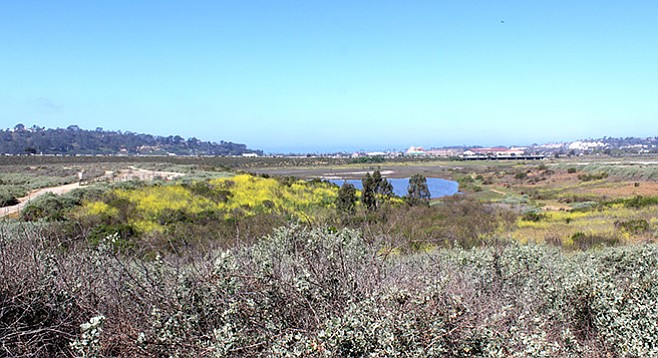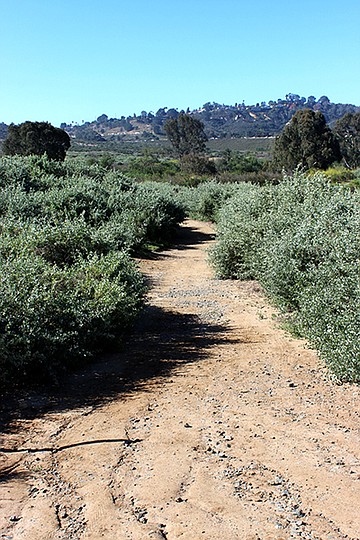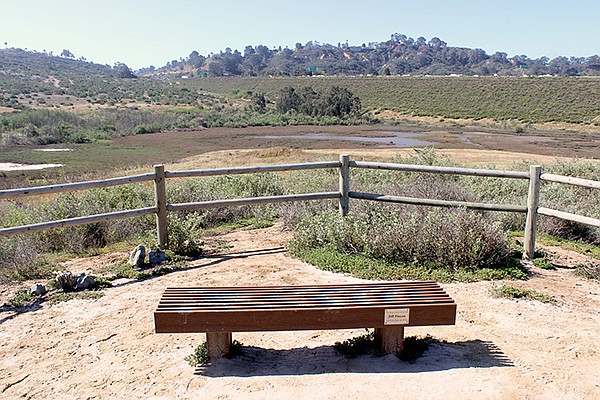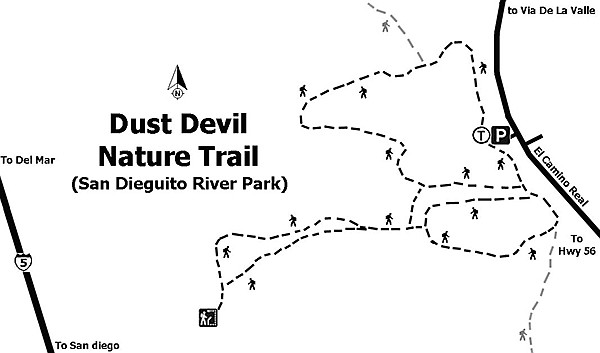 Facebook
Facebook
 X
X
 Instagram
Instagram
 TikTok
TikTok
 Youtube
Youtube


The Dust Devil Trail was named in honor of the Dust Devils, a group of volunteers dedicated to preserving the trails within the San Dieguito River Park. Their work with park rangers includes trail building and restoration and management of park habitat. The trail has three loops and is popular with nearby residents who use the trails to walk their dogs, stroll, and jog. Much of the area along the trail went through restoration just after 2014, and the vegetation is slowly taking hold. There is no shade, but a fresh sea breeze often keeps the area cool, allowing this to be hiked during all times of the year. A hat and sunscreen are recommended.

All three loops can be accessed from the parking area, with the north trail the longest. It begins at the trailhead and trends north through areas of Mexican manzanita and saltbush. Portions of intact coastal scrub can be seen to the east. The trail turns west and hikers can enjoy a view of the San Dieguito River Valley. The valley was part of an ancient seafloor that was uplifted by tectonic action. The San Dieguito River, which originates near Volcan Mountain, has carved a mile-wide valley and deposited sediments near the mouth of the river. This eventually created a bay that later turned to marshland as sediments continued to build up near the river mouth. A seasonal pond from the river can be seen to the northwest. The trail turns southeast and follows the lagoon access road back to the trailhead.

The west trail branches from the north loop just after it turns east onto the access road. It features a thick stand of Mexican manzanita and a great view of a seasonal pond to the north. This seasonal pond, as well as the one that can be seen on the north loop, are teeming with migratory waterfowl during the winter months, when wood ducks, lesser scaups, buffleheads, mallards, and many other species can be seen. Shorebirds such as herons, curlew, and willits are also frequent visitors to the ponds, though fewer birds are visible during the summer months. Other birds use the open space and patches of Mexican manzanita around the trail to hunt and forage for food. Say’s phoebes, bushtits, and house sparrows are frequently seen. Hummingbirds and yellow-rumped warblers can be observed during winter months.

The east loop is a short, level walk along an oval-shaped path that begins at the south side of the trailhead. A stand of eucalyptus trees can be seen on the southwest side. Eucalyptus trees are not native to California — they are in the myrtle family and come from Australia. They were introduced to Southern California in the 1850s, initially because the straight trunks were thought to make perfect railroad ties, but, unfortunately, the wood split and curled. However, once introduced, they became popular as a landscape plant because they provided shade and were fast-growing. In recent years they have proven to be a major problem because they are a fire-intensive plant that can cause explosive burning due to the trees’ oil content. It is now considered an invasive species that has disrupted ecological relationships among native species. In some areas it is being replaced by native oaks and bay trees.
Distance from downtown San Diego: 23 miles. Allow 35 minutes driving time (Del Mar). From I-5 N, exit east on Via de la Valle to El Camino Real, turning right (south) for 1.2 miles to the parking area and trailhead located on the right.
Hiking length: Three loops totaling 1.7 miles. The north loop is 0.7 mile, the west loop is 0.6 mile, and the east loop is 0.4 mile in length.
Difficulty: Easy with negligible change in elevation. A slight dip of 1–2 feet occurs as the west loop crosses a small drainage near the start of the trail, and a slight rise of 3–5 feet follows a short distance farther as the trail leads to an overlook. The trails are mostly compacted earth surface. Facilities. Dogs (on leashes) allowed.



The Dust Devil Trail was named in honor of the Dust Devils, a group of volunteers dedicated to preserving the trails within the San Dieguito River Park. Their work with park rangers includes trail building and restoration and management of park habitat. The trail has three loops and is popular with nearby residents who use the trails to walk their dogs, stroll, and jog. Much of the area along the trail went through restoration just after 2014, and the vegetation is slowly taking hold. There is no shade, but a fresh sea breeze often keeps the area cool, allowing this to be hiked during all times of the year. A hat and sunscreen are recommended.

All three loops can be accessed from the parking area, with the north trail the longest. It begins at the trailhead and trends north through areas of Mexican manzanita and saltbush. Portions of intact coastal scrub can be seen to the east. The trail turns west and hikers can enjoy a view of the San Dieguito River Valley. The valley was part of an ancient seafloor that was uplifted by tectonic action. The San Dieguito River, which originates near Volcan Mountain, has carved a mile-wide valley and deposited sediments near the mouth of the river. This eventually created a bay that later turned to marshland as sediments continued to build up near the river mouth. A seasonal pond from the river can be seen to the northwest. The trail turns southeast and follows the lagoon access road back to the trailhead.

The west trail branches from the north loop just after it turns east onto the access road. It features a thick stand of Mexican manzanita and a great view of a seasonal pond to the north. This seasonal pond, as well as the one that can be seen on the north loop, are teeming with migratory waterfowl during the winter months, when wood ducks, lesser scaups, buffleheads, mallards, and many other species can be seen. Shorebirds such as herons, curlew, and willits are also frequent visitors to the ponds, though fewer birds are visible during the summer months. Other birds use the open space and patches of Mexican manzanita around the trail to hunt and forage for food. Say’s phoebes, bushtits, and house sparrows are frequently seen. Hummingbirds and yellow-rumped warblers can be observed during winter months.

The east loop is a short, level walk along an oval-shaped path that begins at the south side of the trailhead. A stand of eucalyptus trees can be seen on the southwest side. Eucalyptus trees are not native to California — they are in the myrtle family and come from Australia. They were introduced to Southern California in the 1850s, initially because the straight trunks were thought to make perfect railroad ties, but, unfortunately, the wood split and curled. However, once introduced, they became popular as a landscape plant because they provided shade and were fast-growing. In recent years they have proven to be a major problem because they are a fire-intensive plant that can cause explosive burning due to the trees’ oil content. It is now considered an invasive species that has disrupted ecological relationships among native species. In some areas it is being replaced by native oaks and bay trees.
Distance from downtown San Diego: 23 miles. Allow 35 minutes driving time (Del Mar). From I-5 N, exit east on Via de la Valle to El Camino Real, turning right (south) for 1.2 miles to the parking area and trailhead located on the right.
Hiking length: Three loops totaling 1.7 miles. The north loop is 0.7 mile, the west loop is 0.6 mile, and the east loop is 0.4 mile in length.
Difficulty: Easy with negligible change in elevation. A slight dip of 1–2 feet occurs as the west loop crosses a small drainage near the start of the trail, and a slight rise of 3–5 feet follows a short distance farther as the trail leads to an overlook. The trails are mostly compacted earth surface. Facilities. Dogs (on leashes) allowed.